Original Kit:
Custom Cadillac Lowrider
Made By:
Revell (kit #85-2864)
Scale:
1/25

eBayPartner Affiliate Link
Other Cartoon & Anime Models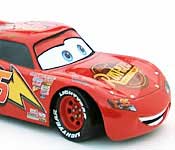
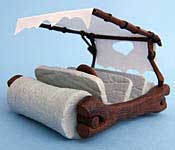
Other 2000s Movie Models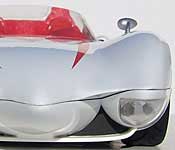
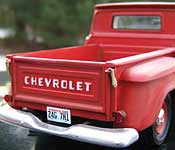
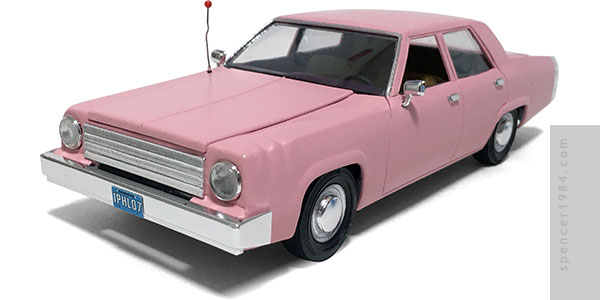
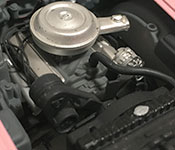
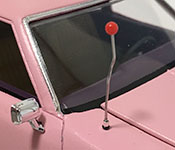
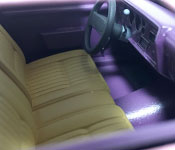
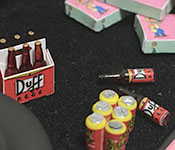
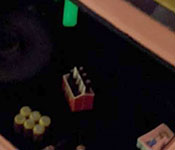
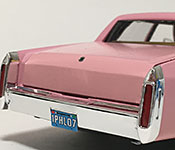
I've wanted to do a Simpsons-themed build since before Polar Lights released their Homer way back in 2003. And while that kit was a perfectly fine (if still unfinished) subject, it wasn't as iconic as the pink Family Sedan. Part of the problem was that at the time there wasn't anything available that even remotely resembled the big boxy car. But then a couple years after Polar Lights' release, Revell dropped a "Custom Cadillac Lowrider" that looked like it might be just what I needed.
Trying to get reference material was little more than an excuse to watch a bunch of episodes: details changed by the episode, scene, and sometimes even mid-scene shot. The main color drifted from magenta to practically off-white (and even green in one episode), the interior was various combinations of brown, purple, orange, maroon, etc., and it would attain and lose features (and damage) according to the whims of the writers. The car was heavily featured and detailed in the episode "The City of New York vs. Homer Simpson," so I decided to use that as my primary source with a few details pulled from other sources.
Said episode showed that the car had a standard longitudinal V8 with a complete post-emissions exhaust system. Easy enough, as the Cadillac had the same thing. I built the engine and chassis box stock, painting everything in shades of grays to reflect the generic colors used in the show. The kit only provided a set of lowrider wheels, so they were used on another project and I modified a set of hubcaps from AMT's '49 Mercury to look like a set of generic dog dish caps on steel wheels. They were painted silver with the centers finished in Bare Metal Foil, then matched to a set of tires from my parts box.
Inside, the floor and rear seat were the only parts that I used right out of the box. The front seat had a set of headrests that were never used in the show and had to be removed. Doing so left a pair of large rectangular holes in the top of the seat, and to fill those I cut two sections of rod stock that were the length of each hole and slightly larger diameter than the hole's width. I then flooded the edges of the holes with liquid cement to soften the plastic and pressed the rods into them, using the round surfaces to deform the edges of the holes and form a solid, permanent bond between the seat and filler plastics. After letting it set for a couple of days, I was able to cut off the excess material and shape the top of the seat as if it was all one piece of plastic. The door panels were made by layering several thicknesses of styrene stock and adding some door handles and window cranks from Model Car Garage and Replicas & Miniatures of Maryland. Finally, the dashboard was a leftover piece from a Monogram Chevelle. It was mated to the filler panel from the Cadillac to ensure a good fit to the windshield, the pad was reshaped a little, and it got a steering wheel from my parts box. I then painted the seats orange and the rest of the panels purple. The details were done using several shades of black and gray. The trunk had a bunch of holes in it for the various lowrider gear, so I simplified my life by going over the whole floor with some craft suede. The rest of the trunk was painted a matching black, and I threw in a few odds and ends: a spare tire from my parts box, some scratch built Buzz Cola cans and Lard Lad donut boxes, a six-pack of Duff Beer with a couple of empties, and a piece of fuel rod made from a glow-in-the-dark toy part. The decals and boxes were all my own custom prints.
The most work, no surprise, had to go to the body. Revell cast the body in several parts, which was awesome for those looking to make it a two-tone and use the vast chrome panels, but slightly less helpful for me here. I had to glue the rocker panels in place, then sand everything level and add a whole lot of filler until it looked more or less uniform...given the roughed-up nature of this car, I wasn't being as picky about removing every tiny divot and crack as I would be on some other projects. The same thing had to be done with the sunroof, after cutting it free from the windshield. I also filled in the sides of the car and scribed a new set of four-door panel breaks. The entire front of the car, outside of the fender arches, was scratch built. Styrene was layered to the top, front, and lower front corners of the car, then blended together. The signature wrinkle in the left fender was sculpted with more filler, cutting down into the layered styrene to make it look appropriate. The hood, like the door panels, was made by layering sheet styrene and then carving it to shape. The rear window was enlarged to match its show appearance, and the trunk lid received a strip of thin styrene across the back panel to delete the Cadillac's license plate recess.
Once the body work was complete, it was time for paint. I went with Rust-Oleum's "Sweet Pea," which was a good generic light pink and very similar to the color LEGO used in their Simpsons House set. While I usually have very good results using Rustoleum's matte colors, the finish on this went to a sandpapery texture that would have been right at home on the flocked Batmobile. It required a great deal of sanding to get even remotely smooth, and still ended up as a weird eggshell finish. Everyone who saw it said that the finish looked appropriate for the car, though, so I left it alone at that point and moved on to final details.
The front bumper and grille were scratch built and finished with BMF. The headlights and bezels were out of my parts box with pin heads acting as bulbs. Like the It's Walky! Dodge, the antenna with its ball topper was made from a straight pin. The door handles were made from short sections of styrene stock covered in aluminum repair tape. The rear bumper was slightly reshaped to allow for the rear plate, and the light inserts were sanded down to remove the cast-in crests. The windshield was the original Cadillac piece, the side windows were made from a Hot Wheels package, and the rear window was a cut-down spare I had in my parts box. Finally, the license plates were custom made and based on the most frequently seen numbers and style seen in the show.
While this may not be my most extensive custom, it's definitely in the top five and I'm glad to finally have this one in the "finished" column.